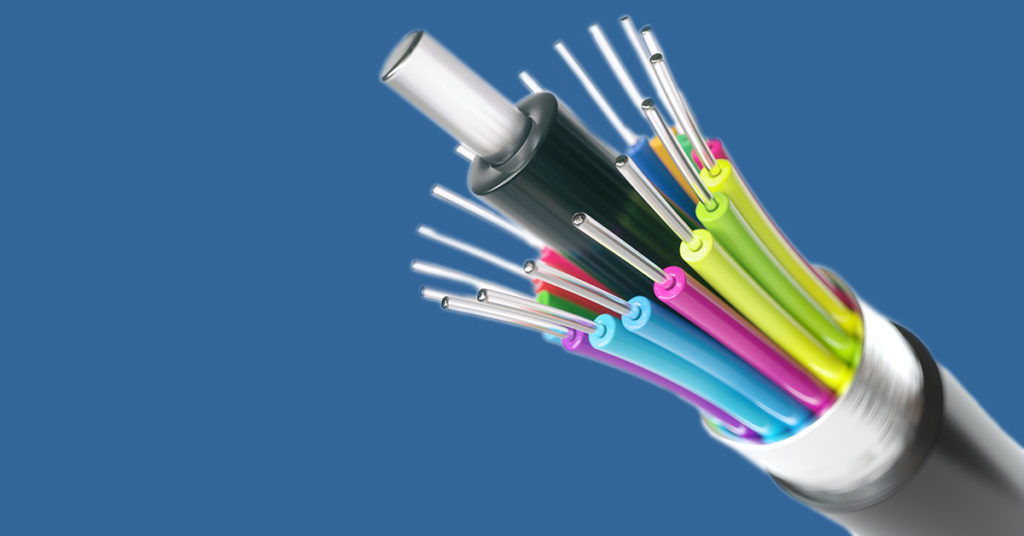
What Is Fiber-Optic Internet?
Updated on September 3, 2025
Everyone talks about fiber-optic internet speed, reliability and efficiency, but do you understand what it is, how it works, and the benefits it brings to your daily life? Fiber-optic internet offers lightning-fast speeds and great performance, but it’s much more than that.
Fiber-optic internet is a cutting-edge broadband technology that delivers data using light signals transmitted through ultra-thin glass or plastic fibers. Fiber can handle large amounts of data with minimal delay, making it ideal for streaming, video calls, gaming, and working from home.
Fiber-optic cables, also known as optical fibers, consist of three parts: a thin inner “core,” surrounded by a slightly thicker “cladding,” both protected by a “buffer” layer that shields the fiber from environmental damage. The core, which is just thicker than a human hair, and the cladding of a fiber-optic cable are typically made from different types of ultra-pure glass. Together, they transmit light at, well, the speed of light, using a technique called “total internal reflection.”
You may remember this from high school science: The glass in the core has a higher “refractive index” than the glass in the cladding. This means that light travels more slowly through the core than through the cladding. It’s similar to how your arm looks like it’s bending when you put it in a swimming pool because water has a higher refractive index than air. In fiber-optic cables, instead of bending and passing through the cladding, the light beam is sent through the core at a shallow angle, which allows it to bounce back. This keeps the light trapped inside the core, traveling from side to side and carrying all that important data.
While optical fiber might seem fragile, it is actually quite robust. The ultra-pure glass used in its construction is flexible, and the buffer effectively keeps moisture, dirt, and other potential threats away from the core and cladding. Multiple fiber-optic wires are bundled together into larger cables, which are wrapped in even thicker protective layers and buried underground to help safeguard them from floods, hurricanes, and other disasters.
The Benefits of Fiber Internet
One of the main advantages of fiber internet is its speed. If you have access to a fiber-to-the-home (FTTH) connection, your internet speeds are secure for the next few decades. You will enjoy fiber connectivity from your computer to the rest of the internet, delivering nearly identical upload and download speeds.
Many fiber providers offer symmetrical upload and download internet speeds, which are seldom available with cable or DSL. This means smoother video conferencing, faster file uploads, and no buffering while streaming your favorite shows.
The Future of Fiber
If you rely on fast, stable internet for work, entertainment, or connecting with family and friends, fiber internet is a game-changer. While availability may differ depending on your location, more cities and communities are seeing expanded fiber coverage each year. As the demand for high-speed internet continues to grow, fiber-optic technology stands out as a future-ready solution designed to handle whatever comes next.
Also Fiber optic cables are designed to withstand harsh weather conditions. The individual strands of fiberglass are wrapped in a protective cladding, then bundled together and wrapped in even more protective materials. It makes them waterproof, weatherproof and temperature-proof. Once a fiber cable is laid, it should last a long time without needing to be replaced.
As science fiction writer William Gibson said, “The future is already here—it’s just not very evenly distributed.” Fiber internet is here now, and in the coming years, it is expected to become much more widely available. This is good news for everyone who wants a fast, stable, and resilient internet connection.
Frontier Fiber is built for the way you live today—and tomorrow.
If you’re still on the lookout for the right ultra fast internet connection for streaming, gaming, working from home and running your smart home—all with enough bandwidth for everybody, find out about Frontier Fiber. Then check here to see when it’s available at your address.
Product features may have changed and are subject to change.


This is really good.
Is there such thing as wireless fiberoptic transmission ?
Hi Julius, good question! Fiber optic is not wireless, however data can be sent wirelessly through the air over light or lasers. Instead of the medium being a closed and highly efficient environment like a fiber optic cable, it is the air. I suppose it could also be the vacuum of space as well, but in all cases there is the possibility of particles or obstructions. Fiber cable allows the optical signal to be curved or bent around obstacles and is perfectly clear, whereas an optical signal outside of fiber would need to be line of site. Due to these limitations, Wi-Fi over radio waves is a better choice since line of sight, while ideal, isn’t absolutely required. For that reason it’s probably best we keep optical wireless data transmission limited to our TV remotes!
Can I get internet without a phone connection? I took out my landlines when I got my first cell phone.
With Fiber to the Home, yes, absolutely. No phone line required. We’ll bring a fiber optic line to your house and install an Optical Network Terminal. From there your home network would connect using Ethernet or Coaxial wiring that we install or which already exists. We offer phone service over fiber but it’s not required. ^Michael
We have phone service thru a subcontractor to frontier- southern California Telecom service. How will thst change? Will we get our same telephone service plus new internet service? Comcast is our internet and cable provider currently.
Hi Jerry, this is a great question. Since your phone service is through a competitive local exchange carrier (CLEC) currently, nothing would change if you were to sign up for Frontier Fiber. You would have the option to port your number back to our network and we could deliver voice service to your home over the fiber line using VoIP technology. ^Michael
Just had fiber installed less than a week ago.
I would like to unplug the fiber cable to move the moden and plug back in. Is this ok to do? Or will I have to call to get it set back up again.
Hey Robert! There is no modem with a Frontier Fiber installation, the device that would most likely be confused for one and that the optical cable connects to is the Optical Network Terminal (ONT). If this is the device you’re referring to, which is typically mounted to a wall, we would advise against disconnecting anything from it. If you’re referring to your router, also often mistaken for a modem, which is connected to the ONT by Ethernet or Coaxial wiring, this is something that you can definitely work on, disconnect and reconnect. ^Michael
Hello,
Our home has cable wires going to each room. When Verizon first installed Fiber into our condo complex, it brought the Fiber into the garages. They installed a Fiber unit there and then connected to our cable connector. I guess the box in the garage was a converter. So in my home I use internet service only, and use a Linksys cable modem and Linksys 3 unit Velop Wifi router mesh. I can’t seem to find a Cable version of the EERO Pro 6 described. How would I move to your Fiber system.
Great question, Robert! Just like when your original Fiber was installed with the Optical terminal in the garage, we can utilize Ethernet as well as coaxial cable to bring the connection inside, as your current connection does. We use a technology called MoCa which can transport data at speeds up to 2.5Gbps over your existing coax wiring. We can also pull Ethernet cable from garage to interior spaces. ^Michael
I just dug my trench for my electrical power feed to my home. I am going to use the same trench for the Frontier fiber optic line. How much dirt do I need to back fill on top of the electrical? Essentially how much dirt is needed to separate the 2 lines so I don’t get interference?
Thanks
That’s a great question, Bill. If your service with us will be Fiber Optic there would be no interaction with your commercial power since the Fiber is transmitting pulses of light. If your service with us, or one of our cable competitors, is delivered over metallic lines you would want them to be 12 inches apart if they’re parallel. ^Michael